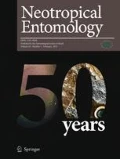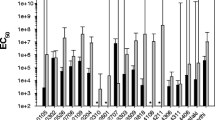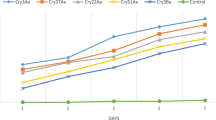Abstract
The citrus fruit borer, Ecdytolopha aurantiana (Lima, 1927) (Lepidoptera: Tortricidae), is responsible for major losses to the citrus industry because it causes rot and drop of fruits. The current study aimed to select and characterize Bacillus thuringiensis (Berliner, 1911) strains toxic to E. aurantiana. For this purpose, 47 B. thuringiensis strains were evaluated in selective bioassays using first instar larvae of E. aurantiana. The lethal concentration (LC50) of the most toxic strains was estimated, and the strains were characterized by morphological, biochemical, and molecular methods. Of the 47 strains tested, 10 caused mortality above 85% and showed mean lethal concentrations between 1.05E+7 and 1.54E+8 spores mL−1. The lowest LC50 values were obtained for the HD-1 standard strain and the BR145, BR83, BR52, and BR09 strains. The protein profile showed the presence of Cry proteins of 60, 65, 70, 80, and 130 kDa. The molecular characterization showed the presence of cry1, cry2, cry3, and cry11 genes. The morphological analysis identified three different crystalline inclusions: bipyramidal, round, and cuboidal. The cry1 and cry2 genes were the most frequent among the B. thuringiensis strains evaluated and encode Cry proteins toxic to insects of the order Lepidoptera, which agree with the toxicity results obtained by the selective bioassays against E. aurantiana. The results showed four different B. thuringiensis strains toxic to E. aurantiana at the same level as the HD-1 standard strain, and these strains have biotechnological potential for E. aurantiana control through the production of transgenic plants or the formulation of biopesticides.

Similar content being viewed by others
References
Abbott WS (1925) A method of computing the effectiveness of an insecticide. J Econ Entomol 18:265–267
Agostini LT, Duarte RT, Volpe HXL, Agostini TT, Carvalho GA, Abrahão YP, Polanczyk RA (2014) Compatibility among insecticides, acaricides, and Bacillus thuringiensis used to control Tetranychus urticae (Acari: Tetranychidae) and Heliothis virescens (Lepidoptera: Noctuidae) in cotton fields. Afr J Agric Res 9:941–949
Alves SB, Medeiros MB, Tamai MA, Lopes RB (2001) Trofobiose e microrganismos na proteção de plantas: Biofertilizantes e entomopatógenos na citricultura orgânica. Biotecnol Cienc Desenvol 4:16–21
Armengol G, Escobar MC, Maldonado ME, Orduz S (2007) Diversity of Colombian strains of Bacillus thuringiensis with insecticidal activity against dipteran and lepidopteran insects. J Appl Microbiol 102:77–88
Arrieta G, Hernández A, Espinoza AM (2004) Diversity of Bacillus thuringiensis strains isolated from coffee plantations infested with the coffee berry borer Hypothenemus hampei Ferrari. Rev Biol Trop 52:757–764
Arrieta G, Espinoza AM (2006) Characterization of a Bacillus thuringiensis strain collection isolated from diverse Costa Rican natural ecosystems. Rev Biol Trop 54:13–27
Beegle CB, Yamamoto T (1992) Invitation paper (C.P. Alexander Fund): History of Bacillus thuringiensis Berliner research and development. Can Entomol 124:587–616
Ben-Dov SE, Zaritsky A, Dahan E, Barak Z, Sinai R, Manasherob R, Khamraey A, Troitskaya E, Dubitsky A, Berezina N, Margalith Y (1997) Extended screening by PCR for seven cry-group genes from field-collected strains of Bacillus thuringiensis. Appl Environ Microbiol 63:4883–4890
Bertani G (1951) Studies on lysogenesis I. The mode of phage liberation by lysogenic Escherichia coli. J Bacteriol 62:293–300
Bravo A, Sarabia S, Lopez L, Ontiveros H, Abarca C, Ortiz A, Ortiz M, Lina L, Villalobos FJ, Peña G, Nuñez-Valdez ME, Soberón M, Quintero R (1998) Characterization of cry genes in a Mexican Bacillus thuringiensis strain collection. Appl Environ Microbiol 64:4965–4972
Céron J, Ortíz A, Quintero R, Güereca L, Bravo A (1995) Specific PCR primers directed to identify cry1 and cry3 genes within a Bacillus thuringiensis strains collection. Appl Environ Microbiol 61:3826–3831
Crickmore N, Zeigler DR, Feitelson J, Schnepf E, Van Rie J, Lereclus D, Baum J, Dean DH (1998) Revision of the nomenclature for the Bacillus thuringiensis pesticidal crystal proteins. Microbiol Mol Biol Rev 62:807–813
Crickmore N, Baum J, Bravo A, Lereclus D, Narva K, Sampson K, Schnepf E, Sun M, Zeigler DR (2014) Bacilus thuringiensis toxin nomenclature. http://www.btnomenclature.info/ Accessed 02Mai 2014
Downes FP, Ito K (2001) Compendium of methods for the microbiological examination of foods, 4th edn. American Public Health Association, Washington DC, p 676
Finney DJ (1971) Probit analysis.3th ed. Cambridge University Press, Cambridge, p 333
Glare TR, O’Callaghan M (2000) Bacillus thuringiensis: biology, ecology and safety. Chichester. John Wiley & Sons, Nova Jersey, p 368
Greene GL, Leppla NC, Dickerson WA (1976) Velvetbean caterpillar: a rearing procedure and artificial medium. J Econ Entomol 69:487–488
Höfte H, Whiteley HR (1989) Insecticidal crystal proteins of Bacillus thuringiensis. Microbiol Mol Biol R 53:242–255
Höfte H, Rie JV, Jansens S, Houtven AV, Vanderbruggen H, Vaeck M (1988) Monoclonal antibody analysis and insecticidal spectrum of three types of lepidopteran-specific insecticidal crystal proteins of Bacillus thuringiensis. Appl Environ Microbiol 54:2010–2017
Ibarra JE, Rincón MCD, Ordúz S, Noriega D, Benintende G, Monnerat R, Regis L, Oliveira CMF, Lanz H, Rodriguez MH, Sánchez J, Peña G, Bravo A (2003) Diversity of Bacillus thuringiensis strains from Latin America with insecticidal activity against different mosquito species. Appl Environ Microbiol 69:5269–5274
Lecadet MM, Chaufaux J, Ribier J, Lereclus D (1992) Construction of novel Bacillus thuringiensis strain with different insecticidal activities by transduction and transformation. Appl Environ Microbiol 58:840–849
Lereclus D, Delécluse A, Lecadet MM (1993) Diversity of Bacillus thuringiensis toxins and genes. In: Enwistle PF, Cory JS, Beliley MJ, Higgs S (eds) Bacillus thuringiensis, An Environmental Biopesticide: Theory and practice.West Sussex, England, pp 37–69
Li H, Oppert B, Higgins RA, Huang F, Buschman LL, Zhu KY (2005) Susceptibility of Dipel-resistant and -susceptible Ostrinia nubilalis (Lepidoptera: Crambidae) to individual Bacillus thuringiensis protoxins. J Econ Entomol 98:1333–1340
López-Pazos SA, Martínez JW, Castillo AX, Cerón-Salamanca JA (2009) Cry1B and Cry3A are active against Hypothenemus hampei Ferrari (Coleoptera: Scolytidae). J Invertebr Pathol 101:242–245
Manachini B (2002) Compatibility of chemical and biological pesticides. In: Pimentel D (ed) Encyclopedia of pest management. Marcel Dekker, New York, pp 134–137
Monnerat RG, Batista AC, Medeiros PT, Martins E, Melatti V, Praça L, Dumas V, Morinaga C, Demo C, Gomes ACM, Falcão R, Siqueira CB, Silva-Werneck JO, Berry C (2007) Screening of Brazilian Bacilus thuringiensis isolates active against Spodoptera frugiperda, Plutella xylostella and Anticarsia gemmatalis. Bio Control 41:291–295
Navon A (2000) Bacillus thuringiensis insecticides in crop protection—reality and prospects. Crop Prot 19:669–676
Parra JRP, Bento JMS, Garcia MS, Yamamoto PT, Vilela EF, Leal WS (2004) Development of a control alternative for the citrus fruit borer, Ecdytolopha aurantiana (Lepidoptera, Tortricidae): from basic research to the grower. Rev Bras Entomol 48:561–567
Parra JRP, Lopes JRS, Zucchi RA, Guedes JVC (2005) Biologia de insetos-praga e vetores. In: Matos Junior D, De Negri JD, Pio RM, Pompeu Juinio J (eds) Citros. Instituto Agronômico e Fundag, Campinas, pp 657–683
Pedigo LP (1999) Entomology and pest management 3.ed. Prentice Hall, Englewood, p 691
Polanczyk RA, De Bortoli SA, De Bortoli CP (2012) Bacillus thuringiensis—based biopesticides against agricultural pests in Latin America. In: Marcelo L, Larramendy L, Soloneski S (eds). Integrated Pest Management and Pest Control - Current and Future Tactics. http://www.intechopen.com/books/integrated-pest-management-and-pest-control-current-andfuture-tactics/bacillus-thuringiensis-based-biopesticides-against-agricultural-pests-in-latin-america/Accessed 25 Jan 2014
Porcar M, Juárez-Pérez V (2003) PCR-based identification of Bacillus thuringiensis pesticidal crystal genes. FEMS Microbiol Rev 26:419–432
Praça LB, Gomes ACMM, Cabral G, Martins ES, Sujii ER, Monnerat RG (2012) Endophytic colonization by Brazilian strains of Bacillus thuringiensis on cabbage seedlings grown in vitro. Bt Res 3:11–19
Ricieto APS, Fazion FAP, Carvalho Filho CD, Vilas-Boas LA, Vilas-Bôas GT (2013) Effect of vegetation on the presence and genetic diversity of Bacillus thuringiensis in soil. Can J Microbiol 59:28–33
Roh JY, Choi JY, Li MS, Jin BR, Je YH (2007) Bacillus thuringiensis as a specific, safe and effective tool for insect pest control. J Microbiol Biotechnol 17:547–559
Saadoun I, Al-Momani F, Obeidat M, Meqdam M, Elbetieha A (2001) Assessment of toxic potential of local Jordanian Bacillus thuringiensis strains on Drosophila melanogaster and Culex sp. (Diptera). J Appl Microbiol 90:866–872
Sanahuja G, Banakar R, Twyman RM, Capell T, Christou P (2011) Bacillus thuringiensis: a century of research, development and commercial applications. Plant Biotechnol J 9:283–300
Santos K, Neves PMOJ, Meneguim AM, Santos RB, Santos WJ, Vilas-Bôas GT, Dumas V, Martins E, Praça LB, Queiroz P, Berry C, Monnerat R (2009) Selection and characterization of the Bacillus thuringiensis strains toxic to Spodoptera eridania (Cramer), Spodoptera cosmioides (Walker) and Spodoptera frugiperda (Smith) (Lepidoptera:Noctuidae). Biol control 50:157–163
Silva SB, Silva-Werneck J, Falcão R, Oliveira Neto O, Sá MF, Bravo A, Monnerat RG (2004) Characterization of novel Brazilian Bacillus thuringiensis strains active against Spodoptera frugiperda and other insect pests. J Appl Entomol 128:1–6
Tailor R, Tippett J, Gibb G, Pells S, Jordan L, Ely S (1992) Identification and characterization of a novel Bacillus thuringiensis δ-endotoxin entomocidal to coleopteran and lepidopteran larvae. Mol Microbiol 6:1211–1217
Vidal-Quist JC, Castañera P, González-Cabrera J (2009) Diversity of Bacillus thuringiensis strains isolated from citrus orchards in Spain and evaluation of their insecticidal activity against Ceratitis capitata. J Microbiol Biotechnol 19:749–759
Vilas-Bôas GT, Peruca APS, Arantes OMN (2007) Biology and taxonomy of Bacillus cereus, Bacillus anthracis and Bacillus thuringiensis. Can J Microbiol 53:673–687
Acknowledgments
The authors wish to thank the National Council for Scientific and Technological Development (CNPq) for the financial support.
Author information
Authors and Affiliations
Corresponding author
Additional information
Edited by Ítalo Delalibera Jr – ESALQ/USP
Rights and permissions
About this article
Cite this article
Zorzetti, J., Ricietto, A.P.S., Fazion, F.A.P. et al. Selection and Characterization of Bacillus thuringiensis (Berliner) (Eubacteriales: Bacillaceae) Strains for Ecdytolopha aurantiana (Lima) (Lepidoptera: Tortricidae) Control. Neotrop Entomol 46, 86–92 (2017). https://doi.org/10.1007/s13744-016-0424-8
Received:
Accepted:
Published:
Issue Date:
DOI: https://doi.org/10.1007/s13744-016-0424-8




